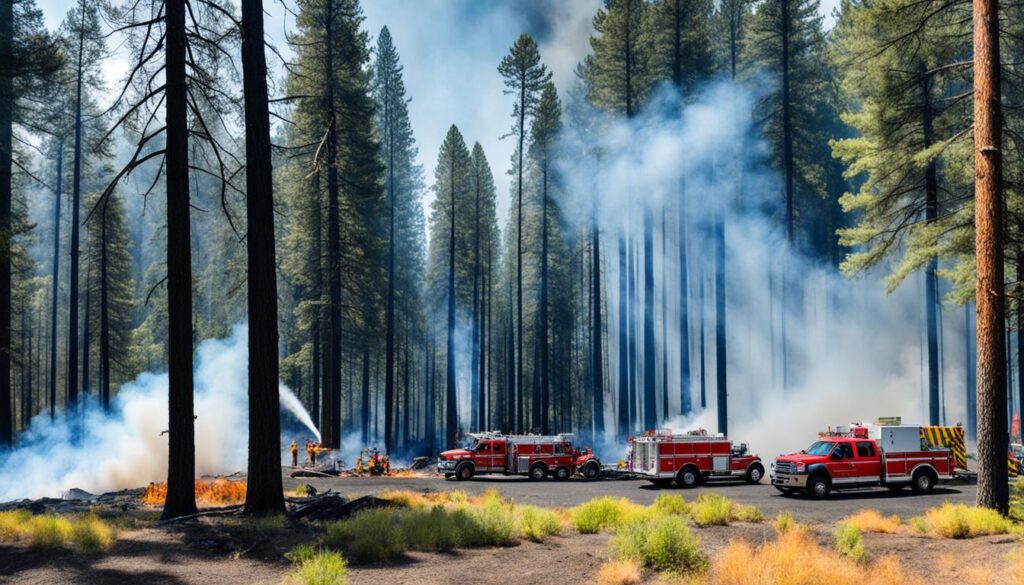Wildfires have grown a lot, causing more damage to buildings from 2005 to 2020. This shows we need new ways to fight fires. Now, we use strategy and science, not just bravery and water. We need new ways to stop big fires that affect many people.
The Wildland Fire Management Strategy has a three-part plan. It aims to make landscapes resilient, adapt communities to fires, and improve how we fight fires. But, most homes lost to fires in 2021 were not in forests. This shows we must fight fires in many places, where people live close to nature.
With over 1.5 billion acres of land, we must change how we manage fires. We need to be proactive, not just reactive. Using controlled fires helps a lot, as seen in the success of 23,050 burns. This shows we can fight fires with careful planning and teamwork.
To protect against fires, we need healthy forests. Some methods, like thinning trees, can make forests less prone to fires. But, this costs money. The 2018 funding helps ensure we have enough money to fight fires until 2027.
Managing fires requires careful planning and rules. Laws like the Healthy Forest Restoration Act help protect communities. These plans are key to fighting fires and protecting nature for the future.
We need to check if these plans work well. Looking at data and feedback from firefighters is important. This helps us see if our efforts are making a difference.
The Role of State Forestry Agencies in Wildfire Management
State forestry agencies in the U.S. are key in fighting wildland fires. They make important plans to control fires and keep forests healthy. Their work helps forests stay strong and safe.
Effective Use of Prescribed Burning
Prescribed burning is key to keeping forests healthy. In 2020, over 8 million acres were burned on state and private lands. This helps prevent big fires and keeps forests in balance.
Financial Burden and Suppression Funding
Wildfires cost a lot of money to fight. In 2022, the government spent over $4 billion on firefighting. States added another $1.9 billion. This money helps fight fires and control wildfires.
Lawmakers think they’ll need to spend more each year. This shows how serious and common wildfires are getting.
Improving Forest Health to Mitigate Wildfire Risks
Keeping forests healthy helps prevent fires. Groups work together to make forests stronger. They thin trees, manage plants, and use controlled burns to lower fire risks.
Strategies for Controlling Large Wildland Fires
Managing large wildland fires requires a team effort from federal, state, tribal, and local groups. This teamwork helps in effective strategies for controlling wildfires. The goal is to make landscapes and communities ready for fires and respond quickly to them. By doing controlled and cultural burns, we help nature by mimicking natural fires.
These strategies are always getting better with new tech like online fire permits and more money for making landscapes stronger. Techniques to manage forest fires are key to this work.
Big money from laws like the Infrastructure Investment and Jobs Act and the Inflation Reduction Act helps a lot. These laws fund new wildfire suppression tactics. They help fight fires better and prevent them from getting worse.
The Burned Area Emergency Response (BAER) program is quick to start fixing areas after fires. But not all fires need this kind of help. Sometimes, nature can fix itself. The National Park Service now uses different ways to fight fires, keeping people and nature safe.
Fire ecologists study how fires used to be in nature. This helps make plans to use fire wisely. Their work makes fire management better.
Managing wildfires is about keeping people safe, protecting nature, and keeping ecosystems healthy. Most wildfires start from people, so teaching the public to prevent fires is key. The Soberanes Fire shows how dangerous not being careful can be.
The main goal is to keep firefighters and the public safe. This is the core of every wildfire suppression tactic or plan.









